Abstract
2-Chlorodeoxyadenosine (CdA) is active in chronic lymphocytic leukemia, hairy-cell leukemia, and low-grade lymphomas. In part, this spectrum of activity may be attributable to the selective toxicity of CdA to nondividing lymphocytes and monocytes. However, CdA is unstable at acidic pH and is degraded by bacterial nucleoside phosphorylases. The present experiments demonstrate that the 2'-arabino-fluoro derivative of CdA, designated CAFdA, is also directly toxic to quiescent lymphocytes and macrophages. Unlike CdA, CAFdA was stable at pH 2 and resisted degradation by Escherichia coli nucleoside phosphorylase. Cell killing was preceded by the formation of DNA strand breaks and could be prevented by supplementation of the medium with deoxycytidine. The initial DNA damage initiated the pattern of oligonucleosomal DNA fragmentation characteristic of apoptosis. Mutant lymphoblasts, deficient in deoxycytidine kinase, with elevated cytoplasmic 5'-nucleotidase, or with expanded deoxynucleotide pools secondary to increased ribonucleotide reductase activity, were cross-resistant to both CAFdA and CdA toxicity. One-week oral treatment with CAFdA (1 mg/ml in drinking water) achieved an average plasma concentration of 0.56 microM and eliminated 90% of chronic lymphocytic leukemia cells transplanted into severe combined immunodeficiency (scid) mice. Under the same conditions, CdA was much less active. Collectively, these results suggest that CAFdA could be effective as an oral agent in indolent lymphoproliferative diseases and in autoimmune diseases where lymphocyte and monocyte depletion is desirable.
Full text
PDF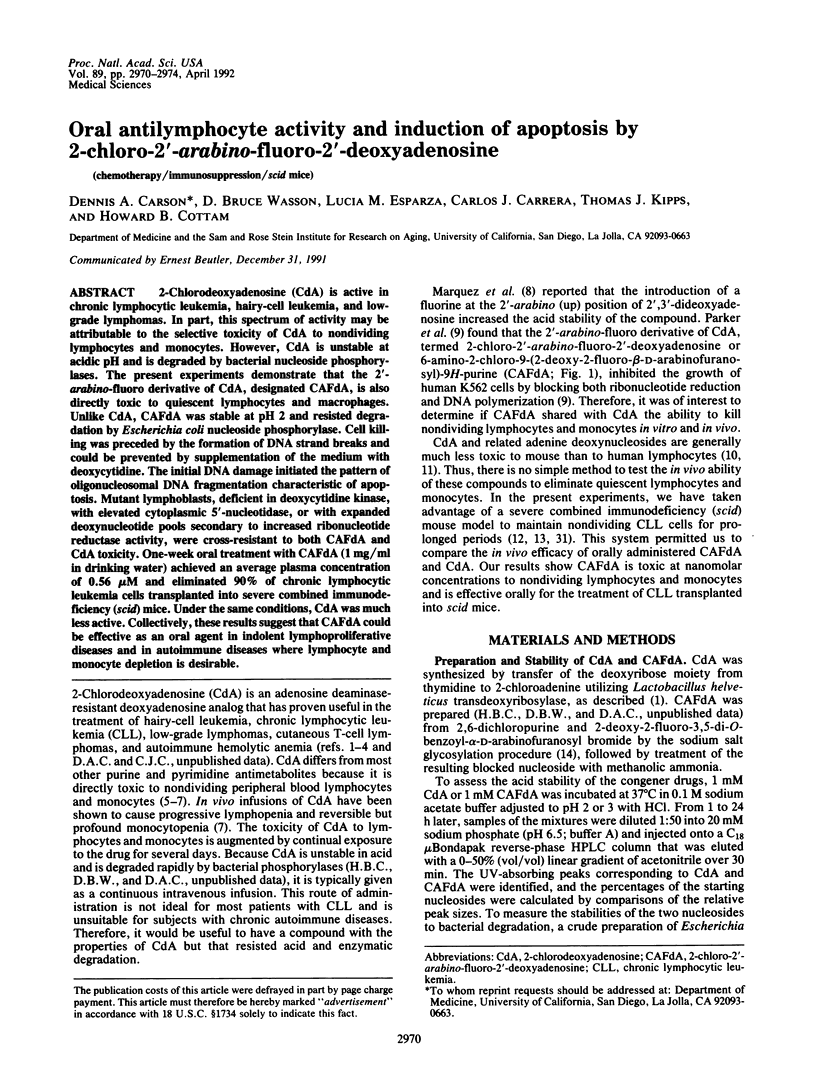
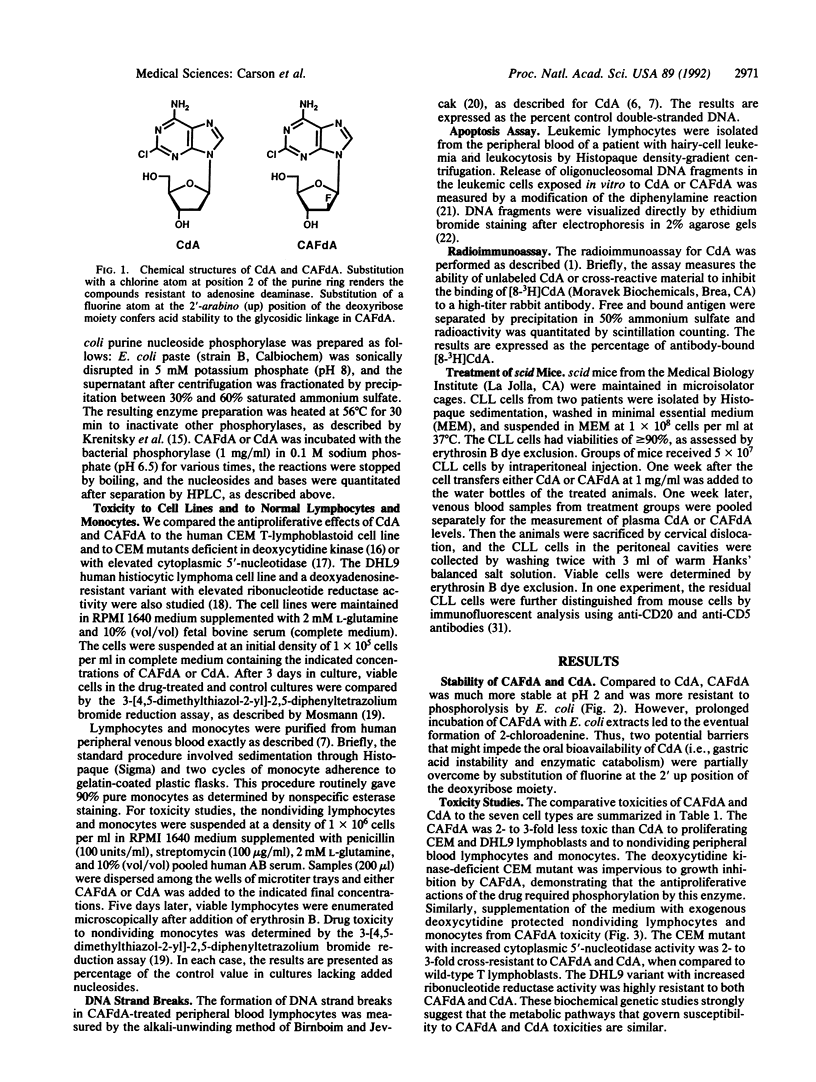
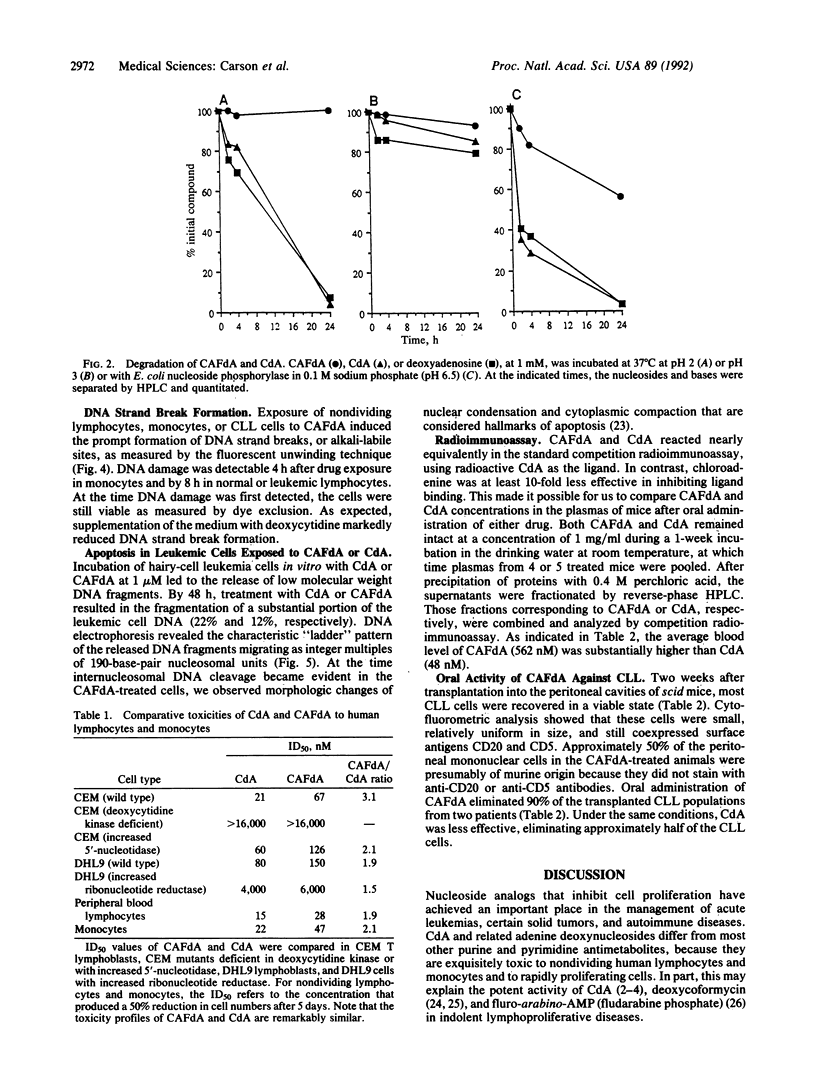
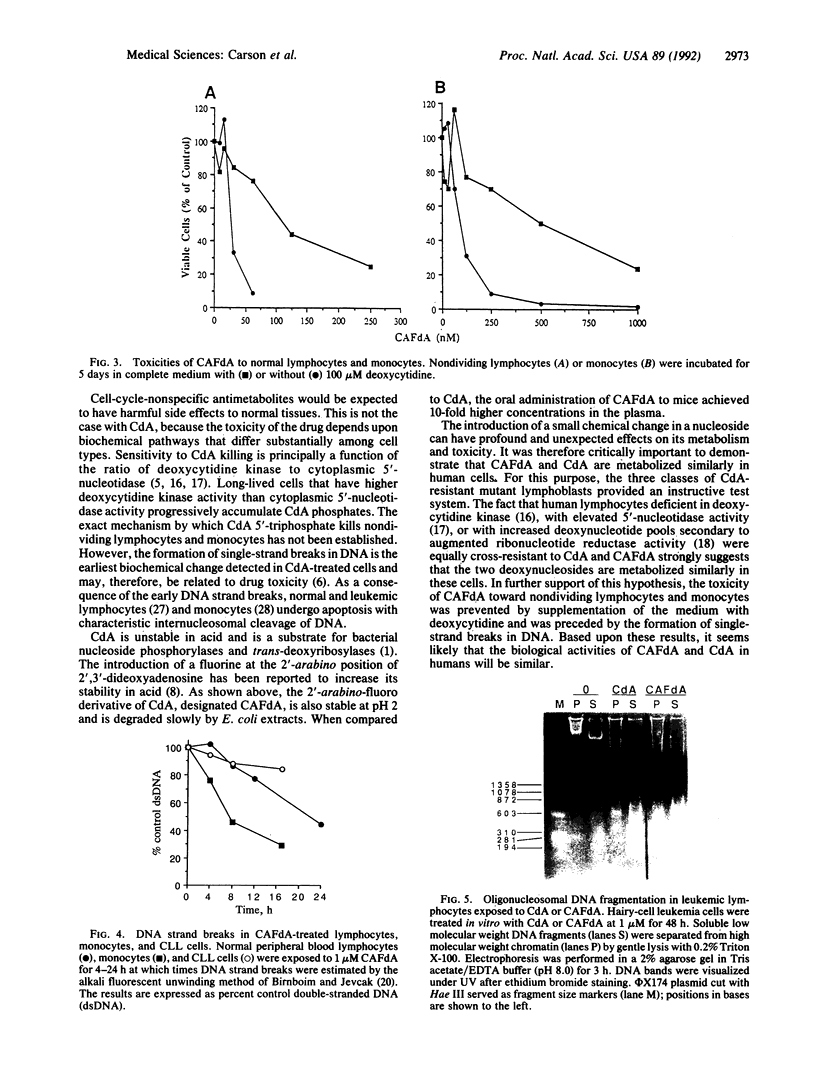
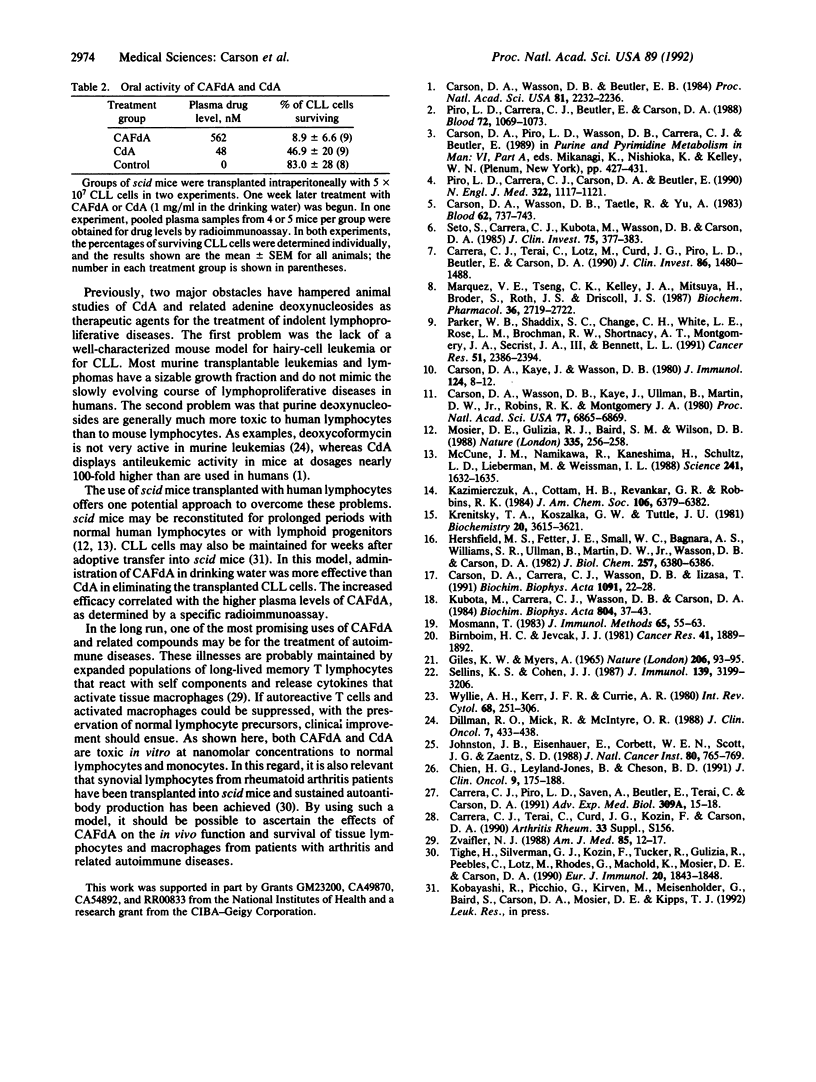
Images in this article
Selected References
These references are in PubMed. This may not be the complete list of references from this article.
- Birnboim H. C., Jevcak J. J. Fluorometric method for rapid detection of DNA strand breaks in human white blood cells produced by low doses of radiation. Cancer Res. 1981 May;41(5):1889–1892. [PubMed] [Google Scholar]
- Carrera C. J., Piro L. D., Saven A., Beutler E., Terai C., Carson D. A. 2-Chlorodeoxyadenosine chemotherapy triggers programmed cell death in normal and malignant lymphocytes. Adv Exp Med Biol. 1991;309A:15–18. doi: 10.1007/978-1-4899-2638-8_3. [DOI] [PubMed] [Google Scholar]
- Carrera C. J., Terai C., Lotz M., Curd J. G., Piro L. D., Beutler E., Carson D. A. Potent toxicity of 2-chlorodeoxyadenosine toward human monocytes in vitro and in vivo. A novel approach to immunosuppressive therapy. J Clin Invest. 1990 Nov;86(5):1480–1488. doi: 10.1172/JCI114865. [DOI] [PMC free article] [PubMed] [Google Scholar]
- Carson D. A., Carrera C. J., Wasson D. B., Iizasa T. Deoxyadenosine-resistant human T lymphoblasts with elevated 5'-nucleotidase activity. Biochim Biophys Acta. 1991 Jan 10;1091(1):22–28. doi: 10.1016/0167-4889(91)90216-k. [DOI] [PubMed] [Google Scholar]
- Carson D. A., Kaye J., Wasson D. B. Differences in deoxyadenosine metabolism in human and mouse lymphocytes. J Immunol. 1980 Jan;124(1):8–12. [PubMed] [Google Scholar]
- Carson D. A., Piro L. D., Wasson D. B., Carrera C. J., Beutler E. Activity of 2-chloro-2'-deoxyadenosine in chronic lymphocytic leukemia, hairy cell leukemia, and autoimmune hemolytic anemia. Adv Exp Med Biol. 1989;253A:427–431. doi: 10.1007/978-1-4684-5673-8_70. [DOI] [PubMed] [Google Scholar]
- Carson D. A., Wasson D. B., Beutler E. Antileukemic and immunosuppressive activity of 2-chloro-2'-deoxyadenosine. Proc Natl Acad Sci U S A. 1984 Apr;81(7):2232–2236. doi: 10.1073/pnas.81.7.2232. [DOI] [PMC free article] [PubMed] [Google Scholar]
- Carson D. A., Wasson D. B., Kaye J., Ullman B., Martin D. W., Jr, Robins R. K., Montgomery J. A. Deoxycytidine kinase-mediated toxicity of deoxyadenosine analogs toward malignant human lymphoblasts in vitro and toward murine L1210 leukemia in vivo. Proc Natl Acad Sci U S A. 1980 Nov;77(11):6865–6869. doi: 10.1073/pnas.77.11.6865. [DOI] [PMC free article] [PubMed] [Google Scholar]
- Carson D. A., Wasson D. B., Taetle R., Yu A. Specific toxicity of 2-chlorodeoxyadenosine toward resting and proliferating human lymphocytes. Blood. 1983 Oct;62(4):737–743. [PubMed] [Google Scholar]
- Chun H. G., Leyland-Jones B., Cheson B. D. Fludarabine phosphate: a synthetic purine antimetabolite with significant activity against lymphoid malignancies. J Clin Oncol. 1991 Jan;9(1):175–188. doi: 10.1200/JCO.1991.9.1.175. [DOI] [PubMed] [Google Scholar]
- Dillman R. O., Mick R., McIntyre O. R. Pentostatin in chronic lymphocytic leukemia: a phase II trial of Cancer and Leukemia group B. J Clin Oncol. 1989 Apr;7(4):433–438. doi: 10.1200/JCO.1989.7.4.433. [DOI] [PubMed] [Google Scholar]
- Hershfield M. S., Fetter J. E., Small W. C., Bagnara A. S., Williams S. R., Ullman B., Martin D. W., Jr, Wasson D. B., Carson D. A. Effects of mutational loss of adenosine kinase and deoxycytidine kinase on deoxyATP accumulation and deoxyadenosine toxicity in cultured CEM human T-lymphoblastoid cells. J Biol Chem. 1982 Jun 10;257(11):6380–6386. [PubMed] [Google Scholar]
- Johnston J. B., Eisenhauer E., Corbett W. E., Scott J. G., Zaentz S. D. Efficacy of 2'-deoxycoformycin in hairy-cell leukemia: a study of the National Cancer Institute of Canada Clinical Trials Group. J Natl Cancer Inst. 1988 Jul 20;80(10):765–769. doi: 10.1093/jnci/80.10.765. [DOI] [PubMed] [Google Scholar]
- Krenitsky T. A., Koszalka G. W., Tuttle J. V. Purine nucleoside synthesis, an efficient method employing nucleoside phosphorylases. Biochemistry. 1981 Jun 9;20(12):3615–3621. doi: 10.1021/bi00515a048. [DOI] [PubMed] [Google Scholar]
- Kubota M., Carrera C. J., Wasson D. B., Carson D. A. Deoxynucleoside overproduction in deoxyadenosine-resistant, adenosine deaminase-deficient human histiocytic lymphoma cells. Biochim Biophys Acta. 1984 May 22;804(1):37–43. doi: 10.1016/0167-4889(84)90096-x. [DOI] [PubMed] [Google Scholar]
- MASTER R. W. POSSIBLE SYNTHESIS OF POLYRIBONUCLEOTIDES OF KNOWN BASE-TRIPLET SEQUENCES. Nature. 1965 Apr 3;206:93–93. doi: 10.1038/206093b0. [DOI] [PubMed] [Google Scholar]
- Marquez V. E., Tseng C. K., Kelley J. A., Mitsuya H., Broder S., Roth J. S., Driscoll J. S. 2',3'-Dideoxy-2'-fluoro-ara-A. An acid-stable purine nucleoside active against human immunodeficiency virus (HIV). Biochem Pharmacol. 1987 Sep 1;36(17):2719–2722. doi: 10.1016/0006-2952(87)90254-1. [DOI] [PubMed] [Google Scholar]
- McCune J. M., Namikawa R., Kaneshima H., Shultz L. D., Lieberman M., Weissman I. L. The SCID-hu mouse: murine model for the analysis of human hematolymphoid differentiation and function. Science. 1988 Sep 23;241(4873):1632–1639. doi: 10.1126/science.241.4873.1632. [DOI] [PubMed] [Google Scholar]
- Mosier D. E., Gulizia R. J., Baird S. M., Wilson D. B. Transfer of a functional human immune system to mice with severe combined immunodeficiency. Nature. 1988 Sep 15;335(6187):256–259. doi: 10.1038/335256a0. [DOI] [PubMed] [Google Scholar]
- Mosmann T. Rapid colorimetric assay for cellular growth and survival: application to proliferation and cytotoxicity assays. J Immunol Methods. 1983 Dec 16;65(1-2):55–63. doi: 10.1016/0022-1759(83)90303-4. [DOI] [PubMed] [Google Scholar]
- Parker W. B., Shaddix S. C., Chang C. H., White E. L., Rose L. M., Brockman R. W., Shortnacy A. T., Montgomery J. A., Secrist J. A., 3rd, Bennett L. L., Jr Effects of 2-chloro-9-(2-deoxy-2-fluoro-beta-D-arabinofuranosyl)adenine on K562 cellular metabolism and the inhibition of human ribonucleotide reductase and DNA polymerases by its 5'-triphosphate. Cancer Res. 1991 May 1;51(9):2386–2394. [PubMed] [Google Scholar]
- Piro L. D., Carrera C. J., Beutler E., Carson D. A. 2-Chlorodeoxyadenosine: an effective new agent for the treatment of chronic lymphocytic leukemia. Blood. 1988 Sep;72(3):1069–1073. [PubMed] [Google Scholar]
- Piro L. D., Carrera C. J., Carson D. A., Beutler E. Lasting remissions in hairy-cell leukemia induced by a single infusion of 2-chlorodeoxyadenosine. N Engl J Med. 1990 Apr 19;322(16):1117–1121. doi: 10.1056/NEJM199004193221605. [DOI] [PubMed] [Google Scholar]
- Sellins K. S., Cohen J. J. Gene induction by gamma-irradiation leads to DNA fragmentation in lymphocytes. J Immunol. 1987 Nov 15;139(10):3199–3206. [PubMed] [Google Scholar]
- Seto S., Carrera C. J., Kubota M., Wasson D. B., Carson D. A. Mechanism of deoxyadenosine and 2-chlorodeoxyadenosine toxicity to nondividing human lymphocytes. J Clin Invest. 1985 Feb;75(2):377–383. doi: 10.1172/JCI111710. [DOI] [PMC free article] [PubMed] [Google Scholar]
- Tighe H., Silverman G. J., Kozin F., Tucker R., Gulizia R., Peebles C., Lotz M., Rhodes G., Machold K., Mosier D. E. Autoantibody production by severe combined immunodeficient mice reconstituted with synovial cells from rheumatoid arthritis patients. Eur J Immunol. 1990 Aug;20(8):1843–1848. doi: 10.1002/eji.1830200832. [DOI] [PubMed] [Google Scholar]
- Wyllie A. H., Kerr J. F., Currie A. R. Cell death: the significance of apoptosis. Int Rev Cytol. 1980;68:251–306. doi: 10.1016/s0074-7696(08)62312-8. [DOI] [PubMed] [Google Scholar]
- Zvaifler N. J. New perspectives on the pathogenesis of rheumatoid arthritis. Am J Med. 1988 Oct 14;85(4A):12–17. doi: 10.1016/0002-9343(88)90356-7. [DOI] [PMC free article] [PubMed] [Google Scholar]



